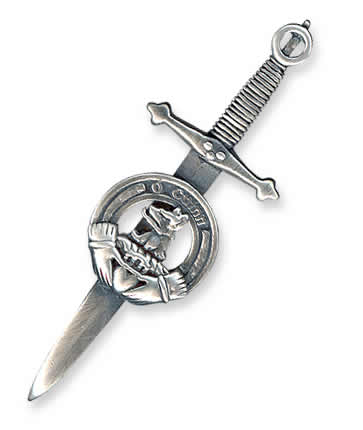 |
The history
of the kilt pin originates with Queen Victoria, who, upon
observing a kilted soldier standing at attention with the
wind whipping his kilt up around his ears, came to his
rescue by pinning the aprons of his kilt together with a pin
she was wearing. Thereafter, it was decreed that all
Scottish regiments would wear some device to hold their
kilts down. Regiments such as the Black Watch, however,
opted for rosettes of ribbon.
Many people
object to the kilt pin because of its feminine origins and
some men refuse to wear a kilt pin at all; while some don't
feel dressed without one. This is certainly optional and my
sentiments tend to fall somewhere between the two extremes.
If you do decide to wear a kilt pin, the proper place to
wear it is three inches from the bottom of the kilt and
three inches inward from the right side of the apron. The
kilt pin should only go through the top apron and not be
pinned to the bottom apron. Any variation in this general
area is considered ok, and if you have a double thickness on
the right side of the apron, you might affix it to that
area. The biggest objection I have to the kilt pin is its
predilection to getting snagged and the possibility of
tearing the kilt. Again, as with the sgian dhub and the
sporran, the kilt pin should be appropriate for the level of
dress and the occasion. Silver or gold kilt pins with jewels
are properly only worn with evening wear. A plain silver or
brass kilt pin is appropriate for daywear.
Some people have problems with
the clasp of their kilt pin coming loose and their pin
falling out and being lost. To prevent this, one idea it to
take the eraser off of a pencil and run it through the back
of your pin as you pin it on your kilt. If the clasp should
come loose, the eraser will keep your pin from falling off. |

